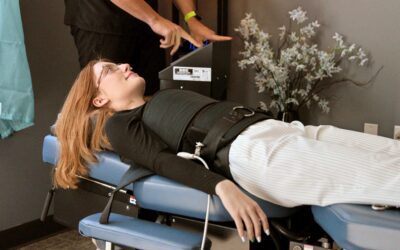Have you ever felt a burning sensation or sharp pain in your legs? Maybe you find yourself sitting at a desk for too many hours, and when you walk up the stairs or go for a stroll you feel tingling or numbness in your lower back or buttock.
This discomfort can stretch from the glutes all the way down your leg. Many people assume this type of radiating leg pain is sciatica, but it could also be a condition called Piriformis Syndrome.
Piriformis Syndrome is a medical condition that causes significant discomfort similar to sciatica-like symptoms. These symptoms originate from the piriformis muscle, a small muscle located deep in the buttocks region, near the top of the hip joint, that plays a pivotal role in hip rotation and lower body movement.
When this piriformis muscle becomes tight or spasms, it can irritate or compress the sciatic nerve, leading to pain, numbness, and tingling down the leg, more commonly known as sciatica. Not all sciatica originates from Piriformis Syndrome.
You need a trained medical professional to accurately diagnose the root cause of your condition and come up with the best plan for treatment.
Anatomy of The Problem Area
When you think of your pelvic girdle, imagine a thin band of muscle that attaches at the base of the spine and connects to your femur. This is the piriformis. The sciatic nerve runs underneath the piriformis and all the way down your leg to your foot.
Symptoms of Piriformis Syndrome
When the piriformis muscle presses against the sciatic nerve it causes pain in the buttocks and low back. It might be difficult to sit down without pain, which could be aching, shooting, or sharp, or dull.
This pain can make it difficult to move due to muscle weakness and tightness. Some people experience numbness and tingling from nerve compression.
Piriformis syndrome can often be mistaken for sciatica. Piriformis syndrome causes pain and other symptoms in the buttocks or hip, and even down the leg. Sciatica can cause pain and nerve discomfort down the leg.
Both conditions can occur at the same time. Since the sciatic nerve passes through the piriformis muscle, if that muscle is tight it can result in sciatic symptoms all the way down the leg and foot.
Causes of Piriformis Syndrome
Piriformis Syndrome has many causes. The muscle may spasm on its own, or as a result of injury. Injuries can cause swelling that worsens the symptoms. Sitting for long periods of time can also worsen pain.
Make sure you warm up before you exercise and work your way gradually into more vigorous exercise, or you may be sidelined by this ailment. Repetitive movement like running can also do it, so listen to your body as you train and be sure to rest regularly.
The root cause of Piriformis Syndrome can be multifaceted, often involving a combination of physical, lifestyle, and genetic factors. Overuse of the piriformis muscle, particularly through activities like long-distance running or repetitive movements that exert strain on the buttocks, can trigger the condition.
Prolonged sitting, whether at a desk job or during long commutes, can also lead to tightened or inflamed piriformis muscles. Trauma or injury to the buttock region, as well as anatomical anomalies, can further contribute to the development of Piriformis Syndrome.
Additionally, factors like poor posture, inadequate warm-up before exercises, or wearing inappropriate footwear can exacerbate the condition.
Diagnosing Piriformis Syndrome
Piriformis syndrome can be diagnosed by a trained medical professional who will perform gentle movements to rule out other causes of pain. It is helpful to tell your doctor about your lifestyle and recent activities.
Your chiropractor will start with a comprehensive assessment to confirm the diagnosis of Piriformis Syndrome, ruling out other potential causes of these symptoms. This includes a detailed history, physical examination, and could potentially require advanced diagnostic imaging techniques.
Chiropractic Treatment For Piriformis Syndrome
Once the diagnosis is confirmed, your chiropractor will design a personalized treatment plan. This plan often includes a combination of spinal adjustments, soft tissue therapy, and specific stretching and strengthening exercises.
These spinal adjustments help to realign the spine, improving overall body mechanics and reducing the strain on the piriformis muscle. Soft tissue therapy can relieve muscle tension, increase blood flow, and promote healing in the affected region.
Chiropractic care can offer a safe, non-invasive, and effective solution to alleviate the discomfort associated with Piriformis Syndrome. Chiropractic treatments are uniquely positioned to address the root cause of the issue, rather than just masking the symptoms. The objective is to restore the normal function of the piriformis muscle, thereby reducing the pressure on the sciatic nerve.
Massage therapy can help release nearby muscles, and chiropractic care will help your body stay in alignment and reduce risk of reinjury.
Specific exercises and stretches can help restore flexibility and strength to the piriformis muscle, reducing the risk of recurring symptoms. Your chiropractor might also suggest lifestyle modifications, such as ergonomic adjustments at your workplace or changes in your exercise regimen, to prevent future flare-ups.
Remember that early intervention is key in managing Piriformis Syndrome effectively. Ignoring the symptoms can lead to chronic pain, reduced mobility, and even permanent nerve damage. So, if you are experiencing persistent lower back pain, buttock pain, or sciatica-like symptoms, it might be time to seek a professional chiropractic evaluation.
Chiropractic Treatment Options Worth Exploring
When a patient with back pain and tingling down their legs comes into our chiropractic office, we perform a full physical examination to determine the cause of these symptoms. If a specific cause can’t be pinpointed, we may have the patient seek additional imaging tests, such as an x-ray or MRI.
Once the cause has been determined, your chiropractor may suggest one or more of the following treatment options:
Chiropractic Care for Back Pain or Tingling Down the Legs at 417 Spine
If you’re searching for chiropractic care to treat Piriformis Syndrome or sciatica in Springfield Missouri, Dr. Matt Maurer & Dr. Charles Maurer are here to help. Our chiropractors and their team understand just how significant back pain or tingling down the legs can be for your musculoskeletal health and how crucial it is to seek the necessary treatments should they become chronic.
Chiropractic treatment provides holistic, patient-centered treatment, focusing on education, prevention, and long-term wellness. Don’t let Piriformis Syndrome or sciatica keep you sidelined from your active life. Reach out to the team at 417 Spine and take your first step towards a pain-free life today.
Have you been experiencing back pain or tingling down your legs? Contact us today to schedule an appointment with Dr. Matt Maurer or Dr. Charles Maurer.


